Related Research Articles

Droseraceae is a family of carnivorous flowering plants, also known as the sundew family. It consists of approximately 180 species in three extant genera. Representatives of the Droseraceae are found on all continents except Antarctica.

The Venus flytrap is a carnivorous plant native to the temperate and subtropical wetlands of North Carolina and South Carolina, on the East Coast of the United States. Although various modern hybrids have been created in cultivation, D. muscipula is the only species of the monotypic genus Dionaea. It is closely related to the waterwheel plant and the cosmopolitan sundews (Drosera), all of which belong to the family Droseraceae. Dionaea catches its prey—chiefly insects and arachnids—with a "jaw"-like clamping structure, which is formed by the terminal portion of each of the plant's leaves; when an insect makes contact with the open leaves, vibrations from the prey's movements ultimately trigger the "jaws" to shut via tiny hairs on their inner surfaces. Additionally, when an insect or spider touches one of these hairs, the trap prepares to close, only fully enclosing the prey if a second hair is contacted within (approximately) twenty seconds of the first contact. Triggers may occur as quickly as 1⁄10 of a second from initial contact.

Rapid plant movement encompasses movement in plant structures occurring over a very short period, usually under one second. For example, the Venus flytrap closes its trap in about 100 milliseconds. The traps of Utricularia are much faster, closing in about 0.5 milliseconds. The dogwood bunchberry's flower opens its petals and fires pollen in less than 0.5 milliseconds. The record is currently held by the white mulberry tree, with flower movement taking 25 microseconds, as pollen is catapulted from the stamens at velocities in excess of half the speed of sound—near the theoretical physical limits for movements in plants.

Drosera regia, commonly known as the king sundew, is a carnivorous plant in the sundew genus Drosera that is endemic to a single valley in South Africa. The genus name Drosera comes from the Greek word droseros, meaning "dew-covered". The specific epithet regia is derived from the Latin for "royal", a reference to the "striking appearance" of the species. Individual leaves can reach 70 cm (28 in) in length. It has many unusual relict characteristics not found in most other Drosera species, including woody rhizomes, operculate pollen, and the lack of circinate vernation in scape growth. All of these factors, combined with molecular data from phylogenetic analysis, contribute to the evidence that D. regia possesses some of the most ancient characteristics within the genus. Some of these are shared with the related Venus flytrap (Dionaea muscipula), which suggests a close evolutionary relationship.
Pyrophytes are plants which have adapted to tolerate fire.

Aldrovanda is a genus of carnivorous plants encompassing one extant species and numerous extinct taxa. The genus is named in honor of the Italian naturalist Ulisse Aldrovandi, the founder of the Botanical Garden of Bologna, Orto Botanico dell'Università di Bologna. Aldrovanda vesiculosa has been reported from scattered locations in Europe, Asia, Africa, and Australia.
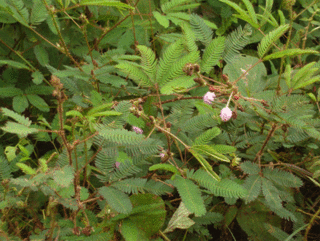
In biology, thigmonasty or seismonasty is the nastic (non-directional) response of a plant or fungus to touch or vibration. Conspicuous examples of thigmonasty include many species in the leguminous subfamily Mimosoideae, active carnivorous plants such as Dionaea and a wide range of pollination mechanisms.
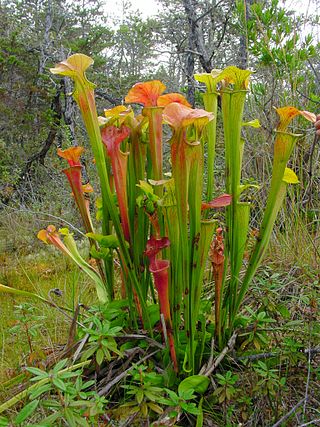
Sarracenia oreophila, also known as the green pitcherplant, is a carnivorous plant in the genus Sarracenia. It has highly modified leaves in the form of pitchers that act as pitfall traps for prey. The narrow pitcher leaves are tapered tubes that rise up to 75 centimetres (30 in) from the ground, with a mouth 6 to 10 centimetres in circumference Like all the Sarracenia, it is native to North America. Sarracenia oreophila is the most endangered of all Sarracenia species, its range limited to a handful of sites in northern Alabama, North Carolina, Georgia, and—historically—Tennessee.

John Ellis aka Jean Ellis was a British linen merchant and naturalist. Ellis was the first to have a published written description of the Venus flytrap and its botanical name. The standard author abbreviation J.Ellis is used to indicate this person as the author when citing a botanical name.

Pameridea is a genus of insects comprising two species, P. roridulae and P. marlothii, that live in symbiotic relationships with carnivorous plants in the genus Roridula. Pameridea marlothii only occurs on R. dentata, while P. roridulae exists on both R. dentata and R. gorgonias.
The Venus flytrap is a carnivorous plant.
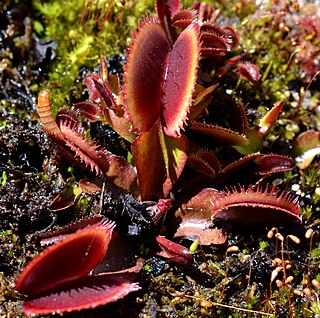
Dionaea muscipula 'Bohemian Garnet' is a cultivar of Dionaea muscipula, the Venus flytrap. It is an F2 cross between Dionaea 'Royal Red' and Dionaea 'Sawtooth' that was published in the September 2007 issue of the Carnivorous Plant Newsletter. In the description of this cultivar, Miroslav Srba noted that it maintains the red coloration of the 'Royal Red' cultivar and most morphological characteristics of 'Sawtooth'. Srba also detailed the smaller size at just 4-6 cm across and the production of many offshoots as novel characteristics that warrant cultivar status. The cultivar name was coined by Srba to honor the country of origin, the Czech Republic (Bohemia), and can be written as Dionaea 'Český Granát'.

Carnivorous plants are plants that derive some or most of their nutrients from trapping and consuming animals or protozoans, typically insects and other arthropods, and occasionally small mammals and birds. They still generate all of their energy from photosynthesis. They have adapted to grow in places where the soil is thin or poor in nutrients, especially nitrogen, such as acidic bogs. They can be found on all continents except Antarctica, as well as many Pacific islands. In 1875, Charles Darwin published Insectivorous Plants, the first treatise to recognize the significance of carnivory in plants, describing years of painstaking research.
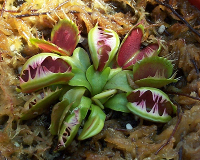
Dionaea muscipula 'Fused Tooth' is a cultivar of Dionaea muscipula, the Venus flytrap. It has webbed teeth that appear in the summer.
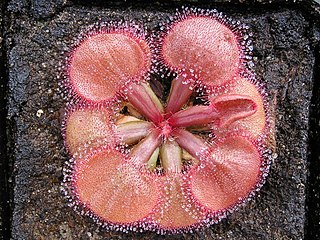
Drosera falconeri is a carnivorous plant in the family of Droseraceae. It is endemic to the Northern Territory of Australia.
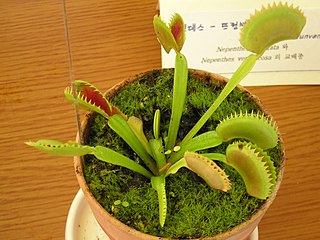
Dionaea muscipula 'Sawtooth' is a cultivar of Dionaea muscipula, the Venus flytrap that has deeply divided "teeth". It was formally described and registered as a cultivar in 2000.
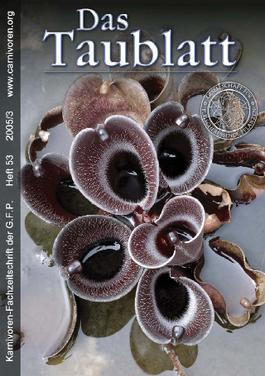
Das Taublatt is a twice-yearly German-language periodical based in Bochum and the official publication of Gesellschaft für Fleischfressende Pflanzen, a carnivorous plant society based in Germany. Typical articles include matters of horticultural interest, field reports, and new taxon descriptions. The journal was established in 1984. It publishes in full colour on glossy paper, with each issue numbering around 52 pages.

Hippasteria muscipula is one of twelve species of deep-sea sea star in the genus Hippasteria, which is in the family Goniasteridae.
A mechanoreceptor is a sensory organ or cell that responds to mechanical stimulation such as touch, pressure, vibration, and sound from both the internal and external environment. Mechanoreceptors are well-documented in animals and are integrated into the nervous system as sensory neurons. While plants do not have nerves or a nervous system like animals, they also contain mechanoreceptors that perform a similar function. Mechanoreceptors detect mechanical stimulus originating from within the plant (intrinsic) and from the surrounding environment (extrinsic). The ability to sense vibrations, touch, or other disturbance is an adaptive response to herbivory and attack so that the plant can appropriately defend itself against harm. Mechanoreceptors can be organized into three levels: molecular, cellular, and organ-level.
References
- http://cpphotofinder.com/dionaea-wacky-traps-367.html
- http://users.humboldt.edu/rziemer/zphotos/VFTWackyTraps.html
- http://www.flytrapcare.com/venus-fly-trap-cultivated-variety-list/wacky-traps-venus-fly-trap.html
- ↑ Schlauer, J. 2010. World Carnivorous Plant List - Nomenclatural Synopsis of Carnivorous Phanerogamous Plants Archived 2016-09-18 at the Wayback Machine . Accessed online: 27 February 2010.